| Surrounded by a deep moat and perched
on a high mound, the huge circular keep of Restormel Castle
was built at the turn of the 14th century. Built as a symbol of wealth and
status and once home to Edward, the Black Prince, it offers splendid views
over the surrounding countryside.
|

|
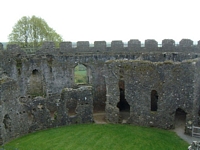
|
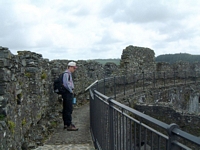
|
| Restormel Castle (107kb)
|
A shot inside the castle, looking across the
center at the far walls. (128kb) |
Peter on the walls (125kb) |
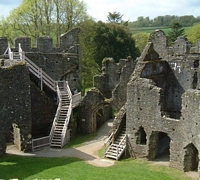
|
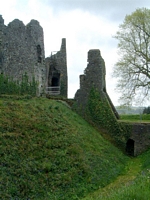
|
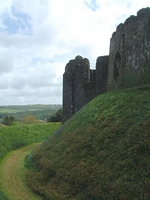
|
| Looking at the entrance to the castle from
the walls.. (228kb) |
The entrance to the castle from the outside. (167kb)
|
The moat around the outside of the walls. (102kb)
|
| Then we drove to the coast to see the
castle most often associated with "King Arthur" ... Tintagel
Castle. With its spectacular location on one of England’s most dramatic
coastlines, Tintagel is an awe-inspiring and romantic spot. It is also a
place of legends. Joined to the mainland by a narrow neck of land, Tintagel
Island faces the full force of the Atlantic. On the mainland itself, the
gaunt remains of the medieval castle represent only one phase in a long
history of occupation. Even before Richard, Earl of Cornwall, built his
castle, Tintagel had come to be associated with the conception of King
Arthur. The connection was later renewed by Alfred, Lord Tennyson, in his
Idylls of the King. The remains of the 13th-century castle are breathtaking. Steep stone
steps, stout walls and rugged windswept cliff edges encircle the Great Hall,
where Richard, Earl of Cornwall, once feasted. The emphasis here is always
on the word ‘may’, as there are so many unanswered questions and legends
surrounding Tintagel. |
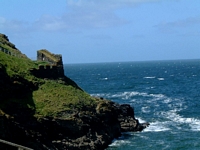
|
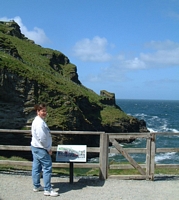
|

|
| Looking out beyond the sheltered cove. (98kb) |
Tintagel is above and behind onthe left.
This railing overlooks to cove on the north side of the island. (182kb)
|
Debbie looking over the railing at the part
of the castle that is on the mainland. (121kb) |
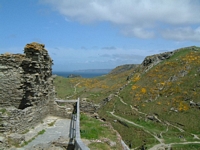
|
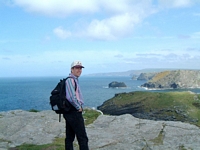
|
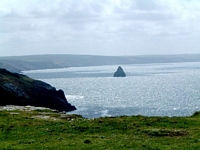
|
| Looking north, up the coast, from the back
edge of the island. (126kb) |
Standing on top of the island, looking
north, up the coast. (91kb) |
Looking south from the other side of the
island. (116kb)
|

|
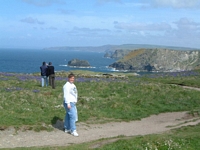
|
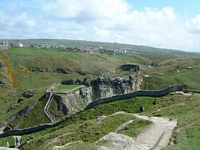
|
| Another shot looking north...The cove is
just visible beyond the edge of the island. (116kb)
|
Deb and a shot to the north.
(112kb) |
Looking over the edge of the island,
and the part of the castle that is on the mainland. (137kb) |
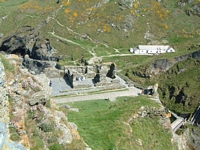
|
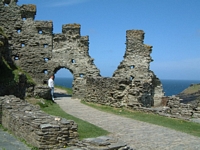
|
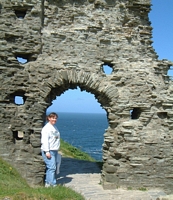
|
| From the top of the island, looking down at
the castle on the island. The bridge to the island is just visible in
the bottom right. (193kb) |
Inside the castle on the island. (149kb)
|
A zoomed in shot (299kb) |
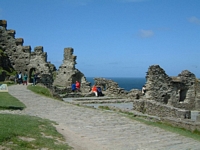
|
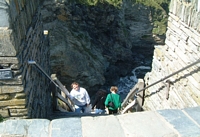
|
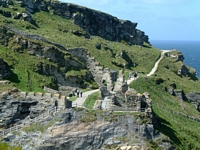
|
| Another view of the castle remains on the
island. (115kb) |
Deb, climbing the steps to the castle on the
mainland. (138kb) |
A great view, from the mainland, of the
castle on the island. (182kb)
|
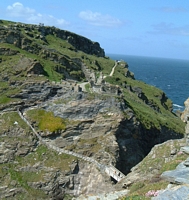
|
|
|
| Another shot from the mainland. Here
you can see the bridge to the island, and the step we climbed to get up to
the castle. (246kb) |
|
|
| Launceston Castle, our next stop, is
set on the high motte of a stronghold built soon after the Norman Conquest.
It was famously used as a jail for George Fox during the reign of Charles
II. As the venue for the county assizes and jail, the castle witnessed the
trials and hangings of numerous criminals. The last execution was in 1821. A
hands-on display at the castle traces 1,000 years of history, with finds
from site excavations.
|
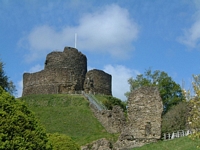
|
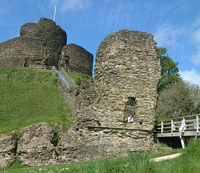
|
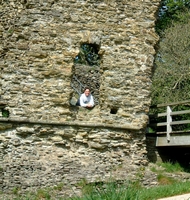
|
| A good picture of Launceston from the bottom (135kb) |
Deb, looking out the window of the
gatehouse. (231kb) |
Zoomed in closer. (343kb)
|
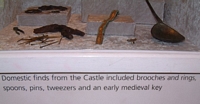
|

|
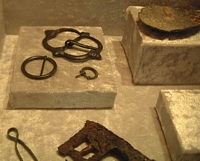
|
| Info on finds from the excavations. (72kb) |
A spoon and a brooch piece. (168kb) |
Some cool buckles. (145kb)
|

|
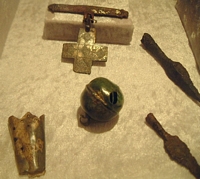 |
 |
| A fitting from a horse harness and a buckle.
(132kb) |
Some arrow heads, and a bell. (170kb) |
Details on the finds.
(64kb)
|
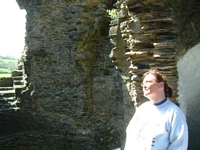
|
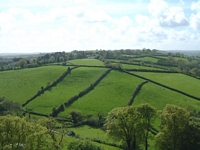
|
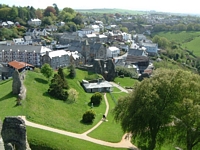
|
| Deb, inside the tower. (128kb) |
A view across the valley from the tower. (106kb) |
A view of the entrance and looking out into
the town. (170kb)
|
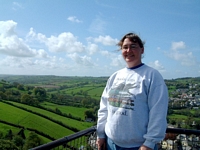
|
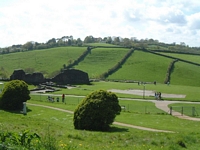
|
|
| A nice shot of Debbie. (104kb) |
Another view across the valley, but from the
bottom of the gatehouse, looking at the castle grounds.. (111kb) |
|